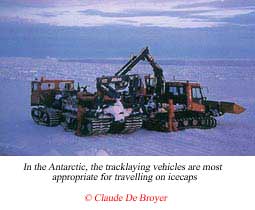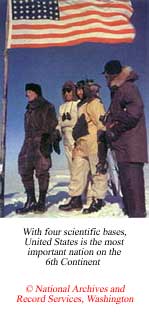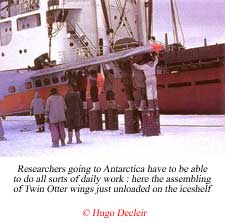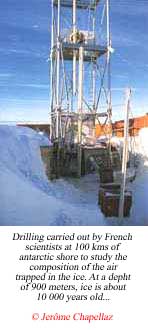|
  
|
 |






|
 Antarctic Polar Regions | A short History of the Antarctic Antarctic Polar Regions | A short History of the Antarctic
A Continent for Science and Adventure ( Page 1)
The International Geophysical Year marks a decisive turning point in the history of the Antarctic. The scientific community, which has made millions of observations of all types, is increasingly convinced that the continent of Antarctica plays a major role in the world's ecosystem; which is why the decision has been taken to continue the adventure. The aim is clear-cut: to take scientific studies to such a level of quality that scientists will be able, within as short a time as possible, to use them in their attempts to begin understanding the phenomena that they have devoted so much time to observing.
Looked at from another angle, the freeze on territorial claims ratified by the signing of the Antarctic Treaty in Washington in 1959 is prompting the various nations interested in the 6th continent to strengthen their scientific presence out on the ice and to push exploration further than ever. |
Crossing the Antarctic by snocat
It all began with a British explorer who, supported by an entire nation, took on the challenge of crossing the continent in its entirety.
Why take up a challenge of this kind? Because even though Scott and Amundsen had proved to the world at large that the South Pole was linked to the Ross Sea by a solid icecap, people were still not totally convinced that what had been discovered up until that point belonged to one and the same continent. Was there not, they wondered, somewhere between the Weddell Sea and the South Pole, in the immense area covered by the final unexplored latitudes, sea ice that had nothing to do with terra firma? And then there was also the memory of the great Ernest Shackleton, who 35 years earlier, had got it into his head to cross the whole continent and who, instead, was to experience the most dramatic Antarctic adventure of all.
The Commonwealth Trans-Antarctic Expedition, led by the British explorer, Vivian Fuchs, made sure that everything was on his side. The crossing was to be in motor vehicles (from the Weddell Sea to McMurdo on the Ross Sea) and would have support from the air, while a support team would be given the task of doing the route in the opposite direction: to depart from the Ross Sea towards the South Pole, so that the second part of Fuchs's journey could be dotted with caches of supplies, equipment and fuel designed to support the main expedition. The explorer in charge of this supply support mission was none other than the New Zealander, Sir Edmund Hillary, the first man to have reached the summit of Everest in May 1953.
The logistics of the expedition were planned with such minute detail that the pathfinding team had to over-winter on the shores of the Weddell Sea in order to construct the camps that were to store the supplies for the expedition before the main attempt got underway. To mark his expedition more effectively, Vivian Fuchs decided to make the British adventure coincide with the International Geophysical Year. So he departed with bag and baggage in January 1957 from Vashel Bay. At the same time, Hillary arrived in the vicinity of the American station at McMurdo; he set up a base camp not far from there at Scott Base. From both sides there were major difficulties in making any progress; the surface of the ice was rarely flat - which made it hard for equipment to be set down by plane, there were many treacherous crevasses, the wind slowed the vehicles down and blizzards regularly paralysed all progress.
This did not prevent their objectives being achieved, especially for Hillary and his men. When they had deposited at the final cache of supplies 800 kilometres from the South Pole, the conqueror of Everest could not think of a single reason why he should not continue and also make his way to the Pole. He had three snocats that were in perfect working order and enough petrol to get there... So Hillary continued on his merry way with his three Ferguson tractors, which to all intents and purposes - snow-chains apart - looked as though they had just left the farmyard. On 3rd January 1958, he reached the South Pole; 16 days later, Vivian Fuchs joined him. Their reunion was brief; because they had encountered too many delays, the British explorer in fact had to make a dash against the clock so that he could arrive at Scott base before the harsh polar winter set in. By 1st March, they had succeeded; man had succeeded in making the first crossing of the continent in its entirety. Fuchs had travelled a distance of 3,472 kilometres in 99 days at an average speed of 35 kilometres a day. And it was true - the Antarctic really was an immense continent of ice.
The American armada disembarks in Antarctic
Instead of claiming any sovereignty over the Antarctic, the United States preferred to take advantage of its undeniable technological superiority to launch a scientific assault on the final continent. The International Geophysical Year (IGY) asked all nations to set up the greatest number of bases possible in Antarctica. The USA held up its hand and decided to go for it in a big way by installing a permanent scientific base… at the South Pole!

Eight years after operation Highjump, which brought 4,000 American soldiers to the Ross Sea to set up the Little America base, the Deepfreeze project was born. The project was carried out in two phases. In 1955-56, a first detachment made up of 7 ships and 1,800 people arrived at McMurdo (in the south-east of the Ross Sea). Their job was to build a landing strip capable of accommodating the heavy aircraft that would bring in the equipment required to construct the base. The location selected for this first base camp (McMurdo) was, after all, 1,500 kilometres from the pole.
Three years later, the main body of troops arrived. 12 ships and 3,400 men - mainly from the military - were mobilised. Not wishing to be ridiculed and fearing failure above all else, the Americans came up with a cautious plan of attack. They first went about setting up an intermediate base between the pole and McMurdo, in the immediate vicinity of the Beardmore glacier (which was on Scott's route); this is where planes en route to the pole would land to refuel. It was also a possible fallback position in the event of an emergency.
On 31st October 1956, the flight to the South Pole took place. 3 US Navy planes set a course due south; the first acted as a pathfinder, the second tested the nature of the terrain and the third was loaded with the first equipment required. That day, admiral Dufek became the 11th man, after Amundsen, Scott and their companions, to set foot on the mythical spot. Five months later, the Amundsen-Scott base (the Americans had the courage to unite forever the names of the two great rivals in Antarctic history) was operational; more than 700 tons of equipment had to be brought in and nearly a hundred "McMurdo-South Pole return trips" were required to complete the project successfully. Operation Deepfreeze could not have been more appropriately named; indeed, on 18th September of the same year, while the head of the scientific mission was taking "a trip around the world" accompanied by a military colleague and his dog, the American meteorologists were already recording a record temperature at the South Pole: -74°C!
Science: in force...
Of course, science had not waited for this unprecedented deployment of logistical resources before setting foot on the Antarctic continent. In fact, the technological age is considered to have begun with the first flights by Byrd over the pole (1929) and the joint observation projects (BANZARE) conducted by the British, New Zealanders and Australians aboard the Discovery. But the arrival of the Americans at the pole and the efforts of the International Geophysical Year (IGY) nevertheless contributed greatly to making scientific research the top priority of everyone interested in the Antarctic at the time. The show of scientific strength displayed by everyone was gigantic: 67 nations took part in IGY, mobilising 25,000 researchers and 4,000 scientific establishments. 12 governments put forward proposals for programmes. It has to be said that the cold war political climate of the time did little to encourage the idea of nation speaking unto nation. Which is one of the reasons why the scientific mobilisation was on such a broad front; the "men from the pole" in fact were aware that if they allowed the politicians to have their way, the fate of the last virgin continent would more than likely be sealed for the worse. 
Before IGY, there were around thirty bases in Antarctica; 1957-58 was to see 55 stations added to this tally, set up either on the mainland itself, or on the surrounding islands. In addition to the spectacular landing at the South Pole described above, the Americans built 4 other bases and turned McMurdo into a genuine little polar city. In 1962, they extended the thrust towards modernism still further by installing an experimental nuclear reactor to produce electricity and heat in abundance; we will see in the chapter on "Protecting the final untouched world" how events led to the Americans having to shut down this mini-power station. As for the Russians, they built no fewer than 15 bases in Antarctica, with 6 on the icesheet and 5 on the east coast. The French, prompted by the initiative of Paul-Emile Victor, who created the French Foundation of Polar Expeditions in 1947, set up the bases of Dumont d'Urville and Charcot; the first of these was located on an island close to the coast, Petrel Island, with the other on the mainland. The Australians and Germans also arrived with their bolt-together kit bases. The Belgians set up the King Baudouin base in 1957. On the Antarctic peninsula alone, no fewer than 25 bases were established by 9 countries - including 9 by Argentina, 4 by Chile and 4 by the United Kingdom.
Although since IGY, scientific activity in the Antarctic has followed fluctuating curves of interest, it can be said that those bases that saw the light of day during this halcyon period were kept in good condition overall - and even developed extensively - during the 25 years after the unprecedented adventure of IGY.
The most obvious effort was made by the United States. US Antarctic activities in the past twenty-five years have been supported by the National Science Foundation (NSF) (1) which sets up annual programmes in conjunction with SCAR (2); since 1958, American research has focused mainly on cartography, the study of ice of at great depths, the study of erosion in the dry valleys, the measurement of cosmic rays, human behaviour in hostile environments, biology, geology, meteorology and oceanography.
|

|
If we had to establish a ranking in international scientific effort, the former Soviet Union would be second, despite the fact that since the fall of communism, Russian activity in the Antarctic has been considerably reined in. However, until 1989, Russia was a leader in Antarctic research. Mirny base on the Davis Sea, with its three-storey buildings and airport, was one of the most modern on the continent. In its day, Molodezhnaya base in the western sector or Enderby Land, was voted "Regional meteorological centre of the Antarctic". The Russian stations conducted research into the ozone layer and, like all of their counterparts, meteorology; their radar has probed the atmosphere and observed the abnormal phenomena of space outside the atmosphere; Vostok has long recorded seismic movements in a deep pit dug using a powerful thermal device. The former Soviet Union also sent out just under a hundred polar expeditions that covered over 100,000 kilometres with sledges towed by caterpillar tractors; in so doing, Russian science has contributed extensively to getting to know the vast desert regions of the eastern icesheet.
As part of this summary of science's conquests of the Antarctic, we should also briefly mention the activities carried out by other interested countries. Because although the number of Antarctic bases has fallen in recent years, scientific work goes on, come hell or high water.
The United Kingdom has bases concentrated on the Antarctic peninsula and on the coast of the Weddell Sea; since the Falklands war, British interest for matters Antarctic have taken an upward swing. Bodies such as the British Antarctic Survey (3) (BAS), which has people on the ground, and the Scott Polar Research Institute, run by Cambridge University, publish numerous information bulletins and contribute extensively to knowledge of Antarctic environments.
Chile maintains three permanent bases in Antarctica and five refuges; as a result of its geographic proximity, Chile's almost military attachment to the last unspoilt continent has always been a strong one, even if its scientific enterprises have been unable to compete with those of the British, for example. Chile is one of those countries that has staked an age-old and effective claim to sovereignty over certain Antarctic territories; according to some, Chile's position is reported to have been strengthened by the fact that the first child born on Antarctic soil was Chilean. Chile has developed a project to populate the Antarctic and has converted a former military building into a hotel with a capacity of 50 beds to accommodate tourists (which is no longer permitted today by the Madrid Protocol). 
Chile's neighbour, Argentina, has joined it in the cause. Argentina has equipped its navy with two ultra-modern polar ships and has built a landing strip. Argentina currently has six bases on Graham Peninsula and three on the coastline of the Weddell Sea, a disputed territorial zone. One of these bases, Esperanza (Hope Bay), boasts of always having accommodated women on Antarctic soil and hence also to have seen Antarctic babies born within its walls. Unlike Chile, there are actual names here; one of the women sent there fell in love with the military chief at the base, a certain Jorge de Palma, and had a child by him. It appears that the baby was born on 7th January 1978 and was baptised Emilio Marcos de Palma.
Two other major countries with interests in the Antarctic are Australia (4 bases) and New Zealand (1 base, Scott Base close to McMurdo); you only have to look at the number of Antarctic websites opened up on the Internet by these two countries to appreciate that in terms of quantity of scientific research at least, they have nothing to envy from their British or American counterparts, and on a political level, they are out there playing with the big boys.
Then there are the other countries that have deployed resources in the Antarctic and continue to do so; in the context of international scientific co-operation, which has been very much in vogue for the past ten years or so, Belgium regularly sends researchers to work with the colleagues from other countries: Japan, France, Britain, New Zealand, Poland, Italy, Australia and America in particular. Norway has a base that is not used all year round and South Africa is actively involved in scientific research; this research is focused on the outlying islands of the continent. Japan, Poland, India and China are also interested in science in the Antarctic; Germany has created a major polar research institute, the Alfred Wegener Institute, and has built a power research ship, the Polarstern, aboard which many Belgian scientists have already worked. France, as we have already seen, made use of IGY to modernise its Dumont d'Urville and Charcot bases; France plays a leading role in climatology and glaciology, thanks in particular to the work of Frenchman Claude Lorius (4) who has spent over 20 years drilling at great depths into the icecap, with the intention of reconstituting the history of climates in the past.
Currently, as the result of phenomena such as the seasonal thinning of the ozone layer, the breaking up of platforms of floating ice and the accelerated formation of icebergs that demonstrate global warming in terms of the climate in particular, some areas of Antarctic science are at the cutting edge of topicality; we will see throughout this work how scientists, after being fenced in on national-based projects and having to some extent worked on projects individually, are today thinking together more than they used to and are establishing much more extensive programmes sans frontières, based on international collaboration and involving researchers from virtually every nation on earth working together.
TO BE CONTINUED NEXT PAGE
--------------------------------------------------------

(1) National Science Foundation (NSF). Established in 1950 in the United States, the NSF is an independent American government agency whose job it is to promote science and engineering through scientific programmes costing 3.3 billion dollars a year (figures for 1996). This covers approximately 20,000 research and education projects. As far as the resources allocated to Antarctic scientific research per se, some 196 million dollars were set aside for this in 1995. 
(2) SCAR is an international, non-governmental, interdisciplinary organisation made up of a broad panel of scientists from all over the world, specialising is an extremely large number of scientific disciplines. SCAR was created under the name of Special Committee for Antarctic Research in 1958 in The Hague. In the wake of the success of the International Geophysical Year, this became the Scientific Committee for Antarctic Research a few years later. The committee is involved in setting up, promoting and co-ordinating international scientific activities in Antarctica. It also plays the role of scientific advisers to member countries of the Treaty of Washington. During the 30 years that SCAR has been carrying out this activity, it can be stated that the advice and recommendations it has issued regarding Antarctic matters have generally not only been followed, but have also sometimes been adopted as the basis for discussion for reaching an agreement. Members of SCAR are trained by national committees that are members of the ICSU (International Council of Scientific Unions); in Belgium, the Belgian National Committee for Antarctic Research is a body that is part of the Royal Academy on Belgium; it is presided over by Gaston de Gerlache and the vice president is the geologist, Tony Van Autenboer, who will be featured at length in the chapter on "A foundation that lives, a foundation that dies". The biologist, Claude De Broyer, and the glaciologist, Hugo Decleir, are the two secretaries for the committee.
(3) The British Antarctic Survey (BAS) is a British research institute under the auspices of the "National Environment Research Council" (NERC), whose main objectives are aimed at conducting high-level scientific research programmes in Antarctica. In addition to progressing knowledge, these programmes are also designed to have Britain play an influential role in the region and to give the country a significant voice at discussions between the member countries of the Treaty of Washington.
The studies conducted by the BAS involve all aspects and areas of science. The BAS benefits from the presence of a number of permanent bases on the ground, which concentrate their efforts on problems that concern both the future of the region (the Antarctic) and the world at large - such as global warming or pollution of the oceans.
(4) Of all the scientists who go or who have been to the Antarctic, the Frenchman Claude Lorius is probably one of the people most entitled to call himself a "man from the pole". Arriving in Antarctica for the first time as a young researcher during the International Geophysical Year, he has gone on to spend over six years on the continent as part of some twenty visits. Lorius has been behind numerous sophisticated scientific techniques for deciphering the information contained in the Antarctic ice - such as the analysis of air bubbles as samples of the atmosphere of long ago, or using the size of crystals as a paleoclimatic indicator, or the analysis of the quantity of occluded gases to demonstrate the altitude of the location where the ice was formed and variations in thickness. This work has led him to be considered by his peers as one of the pioneers of modern glaciology.
(5) Ranulph Fiennes, Mind over Matter, the epic crossing of the Antarctic continent, Sinclair Stephenson, 1993
(6) G.E. Fogg, A History of Antarctic Science, Studies in Polar Research, Cambridge University Press, 1992, pp. 152-53.
|






